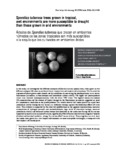Please use this identifier to cite or link to this item:
http://www.alice.cnptia.embrapa.br/alice/handle/doc/1048487| Title: | Spondias tuberosa trees grown in tropical, wet environments are more susceptible to drought than those grown in arid environments. |
| Authors: | ANTUNES, W. C.  MENDES, K. R.   CHAVES, A. R. de M.   OMETTO, J. P.   JARMA-OROZCO, A.   POMPELLI, M. F.   |
| Affiliation: | WERNER CAMARGOS ANTUNES, University of Maringá, Maringá, PR; KEILA RÊGO MENDES, Federal University of Pernambuco, Department of Botany, CCB, Recife, PE; AGNALDO RODRIGUES DE MELO CHAVES, CPATSA; JEAN PIERRE OMETTO, Brazilian Institute for Space Research, Remote Sensing Division, São José dos Campos, SP; ALFREDO JARMA-OROZCO, Faculty of Agricultural Sciences, Agronomy Department, University of Córdoba, Montería, Colombia; MARCELO FRANCISCO POMPELLI, Plant Ecophysiology Laboratory, Federal University of Pernambuco, Department of Botany, CCB, Recife, PE. |
| Date Issued: | 2016 |
| Citation: | Revista Colombiana de Ciencias Hortícolas, v. 10, n. 1, p. 9-27, ene./jun. 2016. |
| Description: | In this study, we investigated the different responses of Spondias tuberosa (umbu) trees, which grow in two different ecological life zones in northeast Brazil: tropical wet and tropical arid ecosystems. We evaluated the responses of plants grown under humid and dry conditions by measuring the photosynthesis, water status, fluorescence parameters, carbon isotopes and antioxidant system activity. The higher net photosynthesis values were recorded contemporaneously with the lower VPD values. The highest internal-to-ambient CO2 concentration and the absence of typical changes in the fluorescence parameters suggested an onset of a nonstomatal limitation in the photosynthesis. Our results showed that umbu plants can adjust their antioxidant activity during the dry season as a defensive strategy against the deleterious effects of water stress. This evidence is supported by the observed modifications in the pigment concentrations, increased accumulation of hydrogen peroxide and malondialdehyde, high levels of electrolyte leakage, increased antioxidant activity, and decreased carbon isotope discrimination in the umbu trees during the dry season. Supported by multivariate analysis of variance, significantly effect of interaction between categorical months of collect and location predicts a strong ?dry season effect? on our dataset. Taken together, our data show that umbu trees grown in a wet tropical environment are more susceptible to drought, as compared with their tropical arid counterparts. |
| Thesagro: | Umbu Caatinga Spondias Tuberosa |
| Keywords: | Estresse hídrico Planta nativa Carbon isotope composition Global climate change |
| DOI: | 10.17584/rcch.2016v10i1.4456 |
| Type of Material: | Artigo de periódico |
| Access: | openAccess |
| Appears in Collections: | Artigo em periódico indexado (CPATSA)  |
Files in This Item:
| File | Description | Size | Format | |
|---|---|---|---|---|
| Agnaldo2016.pdf | 436,8 kB | Adobe PDF |  View/Open |









